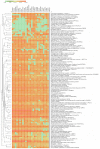Faecal Proteomics and Functional Analysis of Equine Melanocytic Neoplasm in Grey Horses
- PMID: 35202347
- PMCID: PMC8875177
- DOI: 10.3390/vetsci9020094
Faecal Proteomics and Functional Analysis of Equine Melanocytic Neoplasm in Grey Horses
Abstract
Equine melanocytic neoplasm (EMN) is a common disease in older grey horses. The purpose of this study was to examine the potential proteins throughout EMN stages from faecal proteomic outlining using functional analysis. Faecal samples were collected from the rectum of 25 grey horses divided into three groups; normal group without EMN (n = 10), mild EMN (n = 6) and severe EMN (n = 9). Based on the results, 5910 annotated proteins out of 8509 total proteins were assessed from proteomic profiling. We observed differentially expressed proteins (DEPs) between the normal group and the EMN group, and 109 significant proteins were obtained, of which 28 and 81 were involved in metabolic and non-metabolic functions, respectively. We found 10 proteins that play a key role in lipid metabolism, affecting the tumour microenvironment and, consequently, melanoma progression. Interestingly, FOSL1 (FOS like 1, AP-1 transcription factor subunit) was considered as a potential highly expressed protein in a mild EMN group involved in melanocytes cell and related melanoma. Diacylglycerol kinase (DGKB), TGc domain-containing protein (Tgm2), structural maintenance of chromosomes 4 (SMC4) and mastermind-like transcriptional coactivator 2 (MAML2) were related to lipid metabolism, facilitating melanoma development in the severe-EMN group. In conclusion, these potential proteins can be used as candidate biomarkers for the monitoring of early EMN, the development of EMN, further prevention and treatment.
Keywords: equine melanocytic neoplasm; faecal proteome; functional analysis; lipid metabolism.
Conflict of interest statement
The authors declare no conflict of interest.
Figures



Similar articles
-
Probing Wnt pathway and functional signal in equine melanocytic neoplasms through quantitative proteomics and immunohistochemistry.BMC Vet Res. 2025 Aug 7;21(1):509. doi: 10.1186/s12917-025-04956-w. BMC Vet Res. 2025. PMID: 40775356 Free PMC article.
-
Phosphorylation of SNW1 protein associated with equine melanocytic neoplasm identified in serum and feces.Sci Rep. 2024 Dec 28;14(1):30842. doi: 10.1038/s41598-024-81338-6. Sci Rep. 2024. PMID: 39730520 Free PMC article.
-
Preliminary Study: Proteomic Profiling Uncovers Potential Proteins for Biomonitoring Equine Melanocytic Neoplasm.Animals (Basel). 2021 Jun 27;11(7):1913. doi: 10.3390/ani11071913. Animals (Basel). 2021. PMID: 34199079 Free PMC article.
-
Eruptive Melanocytic Nevi: A Review.Am J Clin Dermatol. 2019 Oct;20(5):669-682. doi: 10.1007/s40257-019-00444-8. Am J Clin Dermatol. 2019. PMID: 31119650 Review.
-
In slow pace towards the proteome of equine body fluids.J Proteomics. 2020 Aug 15;225:103880. doi: 10.1016/j.jprot.2020.103880. Epub 2020 Jun 19. J Proteomics. 2020. PMID: 32569818 Review.
Cited by
-
Omics Technologies in Veterinary Medicine: Literature Review and Perspectives in Transfusion Medicine.Transfus Med Hemother. 2023 May 25;50(3):198-207. doi: 10.1159/000530870. eCollection 2023 Jun. Transfus Med Hemother. 2023. PMID: 37408648 Free PMC article. Review.
-
Probing Wnt pathway and functional signal in equine melanocytic neoplasms through quantitative proteomics and immunohistochemistry.BMC Vet Res. 2025 Aug 7;21(1):509. doi: 10.1186/s12917-025-04956-w. BMC Vet Res. 2025. PMID: 40775356 Free PMC article.
-
Phosphorylation of SNW1 protein associated with equine melanocytic neoplasm identified in serum and feces.Sci Rep. 2024 Dec 28;14(1):30842. doi: 10.1038/s41598-024-81338-6. Sci Rep. 2024. PMID: 39730520 Free PMC article.
References
-
- Rieder S., Stricker C., Joerg H., Dummer R., Stranzinger G. A comparative genetic approach for the investigation of ageing grey horse melanoma. J. Anim. Breed. Genet. 2000;117:73–82. doi: 10.1111/j.1439-0388.2000x.00245.x. - DOI
-
- Gorham S., Robl M. Melanoma in the grey horse: The darker side of equine ageing. Vet. Med. 1986;81:446–448.
Grants and funding
LinkOut - more resources
Full Text Sources
Miscellaneous

